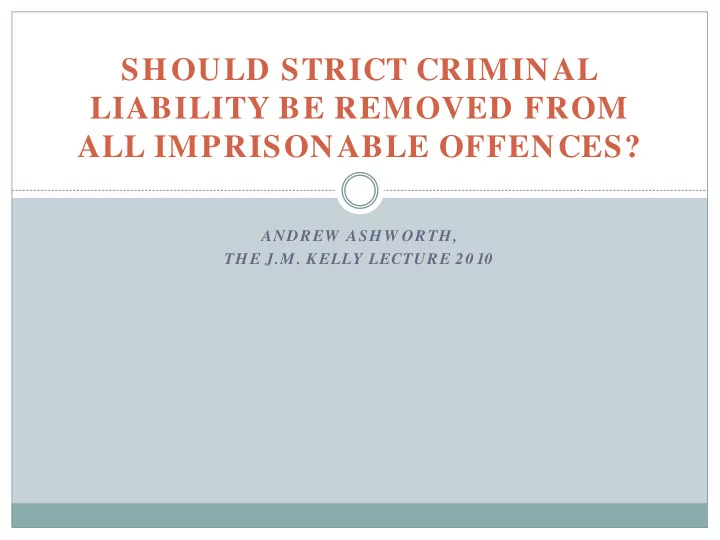

SHOULD STRICT CRIMINAL LIABILITY BE REMOVED FROM ALL IMPRISONABLE OFFENCES? ANDREW ASHW ORTH, THE J.M. K ELLY LECTURE 20 10
What is strict crim inal liability? ‘An offence should be treated as a crime of strict liability if it provides for conviction without requiring fault as to at least one material element.’ Leave out of account ‘risk-based’ offences such as causing death by dangerous driving, where result (death) is part and parcel of ‘danger’ that constitutes dangerous driving.
Reasons for Requiring Fault (1) ‘Rule-of-law’ arguments: H.L.A. Hart – wrong to convict anyone who has not had ‘a fair opportunity’ to exercise the capacity for ‘doing what the law requires and abstaining from what it forbids.’ J. Raz – ‘Respecting human dignity entails treating humans as persons capable of planning and plotting their future. Thus, respecting people’s dignity includes respecting their autonomy, their right to control their future.’
Reasons for Requiring Fault (2) Censure-based arguments: Henry M. Hart – what distinguishes criminal from civil ‘is the judgment of community condemnation which accompanies ... its imposition.’ R.A. Duff – ‘strict liability is therefore both unjust and dishonest: it portrays as proven culpable wrongdoers those who have not been proved to be that.’
Proposition One: “that strict liability as to a m aterial elem ent of an offence is wrong in principle, because the rule-of-law and censure-based argum ents indicate that the prosecution should be required to prove m ens rea (or fault) in relation to all significant elem ents of a crim e, in order to respect the autonom y of individuals and to im pose public censure only where a fair and proper foundation has been laid.”
Exceptions: two English exam ples Possession of a prohibited firearm (min. 5 years, max. 10 years) Rape of a child under 13 (max, life impt). A) the public protection argument B) abnormal difficulty of proving m ens rea C) deterrence D) ‘skating on thin ice’ E) seriousness of the impact on the victim
United Sta tes v . Sta p les (1994): A) possession of an unregistered automatic firearm is a felony; B) D did not know the gun was capable of firing automatically; C) So D did not know registration required; D) Therefore it would be unfair to convict D of this felony in the absence of proof of awareness of this material element.
Three English cases Deyem i and Edw ards (2008) – large torch turned out to be a stun-gun Rehm an and Wood (2006) – replica hand-gun ordered by collector: prohibited firearm G. (2008) – boy of 15 met girl who said she too was 15, but turned out to be 12.
Proposition Two “that neither public protection, nor abnorm al difficulty of proof, nor deterrence, nor the m oralistic doctrine of ‘skating on thin ice,’ nor the seriousness of the im pact of the offence on the victim are sufficient reasons for displacing the principle of m ens rea in favour of strict liability, since conviction without culpability is a very serious m atter for the defendant too; and that these and any other reasons adduced in favour of strict liability m ust be strong enough to defeat the argum ent that a requirem ent of negligence (‘reasonable grounds for believing’) should be adequate.”
Im prisonm ent without Fault Deprivation of basic right; exclusion from community; subjection to pains and deprivations of contemporary imprisonment. Feinberg: ‘The reason why strict liability to imprisonment (punishment) is so much more repugnant to our sense of justice than is strict liability to fine (penalty) is simply that imprisonment in modern times has taken on the symbolism of reprobation.’
Fundam ental Rights European Court of Human Rights in Weeks v. U.K. (1988), developed by English Court of Appeal in R v. Offen (No. 2) (2001). Section 7 of Canadian Charter, in Reference re S. 94(2) of the Motor Vehicle Act (1985). Eighth Amendment to U.S. Constitution, in Weem s v. U.S. (1909); but see now Ew ing v. California and Lockyer v. Andrade (2003) S. 12 of Constitution of South Africa, in S. v. Dodo (2001).
Applying the reasoning Is there a ‘rational relationship between the penalty and the requirements of justice with regard to the punishment of the offence specified’? Lynch and Whelan (2010) ‘An unjustified push can result in someone falling, hitting his head and suffering fatal injuries. The offence is manslaughter. The offender may have committed another serious offence when a young man. A life sentence in such circumstances may well be arbitrary and disproportionate and contravene Article 5. It could also be a punishment which contravenes Article 3.’ R v. Offen (No.2) (2001)
Proposition Three: that convicting a person of a serious offence without proving fault as to a m aterial elem ent of the offence is unfair for both censure-based and rule-of-law reasons that the State should respect; and that it is even m ore objectionable for the State to provide the possibility of deprivation of liberty for an offence which does not require proof of culpability as to all m aterial elem ents. Deprivation of liberty in those circum stances is disproportionate, since the seriousness of the offence is constituted partly by the defendant’s culpability; no fair foundation for im prisonm ent has been laid if culpability is not required as to a significant elem ent in the offence.
Conclusions Cavalier about culpability? Blasé about imprisonment? Need to step up to a higher level of justification in imprisonment cases More rigorous analysis of the elements of public protection arguments.
Recommend
More recommend